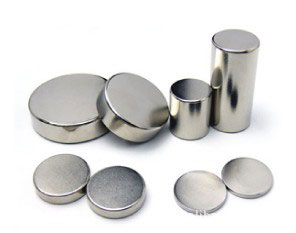Rare earth cobalt permanent magnet material is a permanent magnet material with excellent magnetic properties that emerged in the mid-1960s.
Advantages:
1. Both the residual magnetic induction intensity and the maximum magnetic energy product are very high, in which the residual magnetic induction intensity can be close to the level of AlNiCo materials, and the magnetic induction coercivity is about 3 times that of ferrite permanent magnet materials;
2. The demagnetization curve is basically It is a straight line, and the recovery line basically coincides with the demagnetization curve, and the ability to resist demagnetization is strong;
3. The Curie temperature is high, so this rare earth cobalt permanent magnet material has the best magnetic stability and is suitable for manufacturing high-performance permanent magnets Motor;
Disadvantages:
1. The price is expensive, so it is generally only used in military or special-purpose occasions;
2. It is hard and brittle, with low tensile strength and bending strength.
Neodymium iron boron (NdFeB) permanent magnet material is a high-performance permanent magnet material that came out in 1983.
Advantages:
1. The magnetic performance is higher than the rare earth cobalt permanent magnet, the residual magnetic induction intensity, the magnetic induction coercive force, and the maximum magnetic energy product are all high. It is the permanent magnet with the best magnetic performance at present;
2. High cost performance, because neodymium is in the rare earth The content is ten times that of samarium, the price of iron and boron is also very cheap, and it does not contain cobalt, a strategic material. This is also the reason why NdFeB has been widely used and popularized quickly;
Disadvantages:
1. The Curie temperature is low and the temperature coefficient is high, so the magnetic loss is large when used at high temperature and the magnetic performance is poor in thermal stability;
2. A large amount of iron and neodymium is easy to rust.
It should be noted that the bonded permanent magnet material is not a specific component, but uses materials such as tree branches, plastics or low melting point alloys as adhesives. The advantages of a composite permanent magnetic material made by uniformly mixing with permanent magnetic material powder and then compressing, injection or extrusion molding methods:
Advantages:
1. With large freedom of shape, it is easy to make magnetic rings or thin-walled rings with complex shapes;
2. If it is injection molding, it can be embedded with other parts to form together;
3. High dimensional accuracy, not easy to deform, and no need for secondary processing to make high High-precision magnet;
4. High resistivity, easy to realize multi-pole magnetization;
5. Low performance dispersion, high pass rate, suitable for mass production;
6. High mechanical strength, not easy to break, and can be cut;
Disadvantages:
1. Because it contains adhesive, the magnetic performance is slightly worse.




